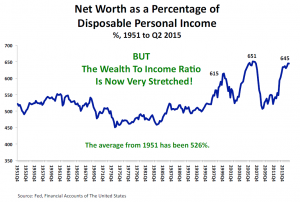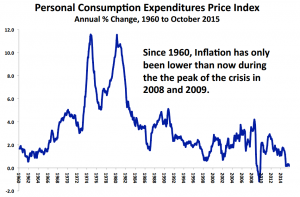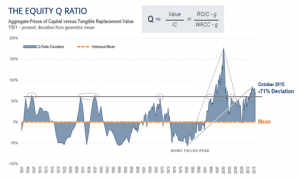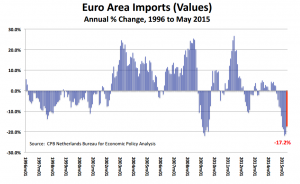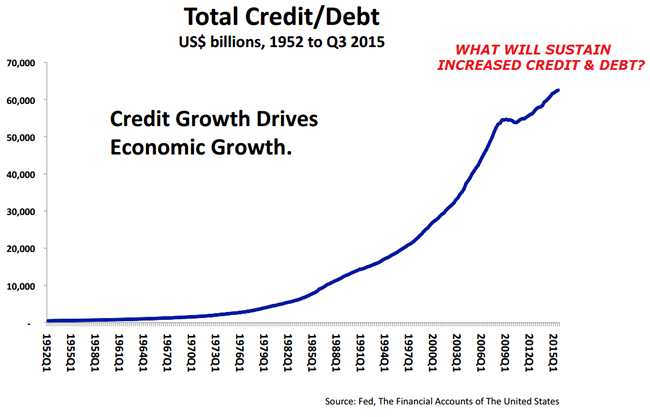|
JOHN RUBINO'SLATEST BOOK |
||||||||||||||||||||||||||||||||||||||||||||||||||||||||||||||||||||||||||||||||||||||||||||||||||||||||||||||||||||||||||||||||||||||||||||||||||||||||||||||||||||||||||||||||||||||||||||||||||||||||||||||||||||||||||||||||||||||||||||||||||||||||||||||||||||||||||||||||||||
"MELT-UP MONITOR " Meltup Monitor: FLOWS - The Currency Cartel Carry Cycle - 09 Dec 2013 Meltup Monitor: FLOWS - Liquidity, Credit & Debt - 04 Dec 2013 Meltup Monitor: Euro Pressure Going Critical - 28- Nov 2013 Meltup Monitor: A Regression-to-the-Exponential Mean Required - 25 Nov 2013
|
�
"DOW 20,000 " Lance Roberts Charles Hugh Smith John Rubino Bert Dohman & Ty Andros � |
�
HELD OVER
Currency Wars
Euro Experiment
Sultans of Swap
Extend & Pretend
Preserve & Protect
Innovation
Showings Below
��
"Currency Wars "
|
�
"SULTANS OF SWAP" archives open ACT II ACT III ALSO Sultans of Swap: Fearing the Gearing! Sultans of Swap: BP Potentially More Devistating than Lehman! |
�
"EURO EXPERIMENT"
archives open EURO EXPERIMENT :� ECB's LTRO Won't Stop Collateral Contagion!
EURO EXPERIMENT: |
�
"INNOVATION"
archives open |
�
"PRESERVE & PROTE CT"
archives open |
�

�
Mon Dec. 28th, 2015
�
Follow Our Updates
�
onTWITTER
https://twitter.com/GordonTLong
�
�
�
�
�
�
| � | � | � | � | � |
ARCHIVES�
| DECEMBER | ||||||
| S | M | T | W | T | F | S |
| � | � | 1 | 2 | 3 | 4 | 5 |
| 6 | 7 | 8 | 9 | 10 | 11 | 12 |
| 13 | 14 | 15 | 16 | 17 | 18 | 19 |
| 20 | 21 | 22 | 23 | 24 | 25 | 26 |
| 27 | 28 | 29 | 30 | 31 | � | � |
KEY TO TIPPING POINTS |
| 1- Bond Bubble |
| 2 - Risk Reversal |
| 3 - Geo-Political Event |
| 4 - China Hard Landing |
| 5 - Japan Debt Deflation Spiral |
| 6- EU Banking Crisis |
| � |
| 7- Sovereign Debt Crisis |
| 8 - Shrinking Revenue Growth Rate |
| 9 - Chronic Unemployment |
| 10 - US Stock Market Valuations |
| 11 - Global Governance Failure |
| 12 - Chronic Global Fiscal ImBalances |
| 13 - Growing Social Unrest |
| 14 - Residential Real Estate - Phase II |
| 15 - Commercial Real Estate |
| 16 - Credit Contraction II |
| 17- State & Local Government |
| 18 - Slowing Retail & Consumer Sales |
| 19 - US Reserve Currency |
| � |
| 20 - US Dollar |
| 21 - Financial Crisis Programs Expiration |
| 22 - US Banking Crisis II |
| 23 - China - Japan Regional Conflict |
| 24 - Corruption |
| 25 - Public Sentiment & Confidence |
| 26 - Food Price Pressures |
| 27 - Global Output Gap |
| 28 - Pension - Entitlement Crisis |
| 29 - Central & Eastern Europe |
| � |
| 30 - Terrorist Event |
| 31 - Pandemic / Epidemic | 32 - Rising Inflation Pressures & Interest Pressures |
| 33 - Resource Shortage |
| 34 - Cyber Attack or Complexity Failure |
| 35 - Corporate Bankruptcies |
| 36 - Iran Nuclear Threat |
| 37- Finance & Insurance Balance Sheet Write-Offs |
| 38- Government Backstop Insurance |
| 39 - Oil Price Pressures |
| 40 - Natural Physical Disaster |
�
Reading the right books?
No Time?We have analyzed & included
these in our latest research papers Macro videos!
OUR MACRO ANALYTIC
CO-HOSTS
John Rubino's Just Released Book
Charles Hugh Smith's Latest Books
Our Macro Watch Partner
Richard Duncan Latest Books
MACRO ANALYTIC
GUESTS
F William Engdahl
OTHERS OF NOTE
�
�
TODAY'S TIPPING POINTS
|
�
�
Have your own site? Offer free content to your visitors with TRIGGER$ Public Edition!
Sell TRIGGER$ from your site and grow a monthly recurring income!
Contact [email protected] for more information - (free ad space for participating affiliates).
HOTTEST TIPPING POINTS |
� | � | Theme Groupings |
||||||||
We post throughout the day as we do our Investment Research for: LONGWave - UnderTheLens - Macro
� |
|||||||||||
|
MOST CRITICAL TIPPING POINT ARTICLES TODAY � |
� | � | � |
||||||||
|
CHECK OUT OUR PAGE DEDICATED TO FINANCIAL REPRESSION The Financial Repression AuthorityTM
|
|||||||||||
| THESIS & THEMES | � | � | � | ||||||||
FINANCIAL REPRESSION |
12-28-15 | � | FINANCIAL REPRESSION |
||||||||
�CITIGROUP’S QE POLICY REPORT CARD: “An ‘F’ Since Everything has Failed”Citi’s Chief Economist Willem Buiter�recently wrote the following�regarding�ECB’s QE policy failure which the FRA�felt would be instructional if US economic graphics (Charts #1 to #6) were added to highlight that it isn’t just an EU problem, but rather a failed policy initiative that has�now becoming counter productive and systemically dangerous if the�ECB�and BOJ were to continue with it and if the Fed & BOE retreat once again to it.
CONCLUSION Quantitative Easing was possibly a viable policy initiative immediately following the 2008 Financial Crisis. However, it was sustained much too long and the global distortions it has created has left the world in a highly fragile state.�The current�economic state is both unstable and critically exposed to an unexpected shock. The central banks are trapped!�They can neither stimulate growth nor reduce the global credit/debt levels and leverage without catapulting the global economy�into an economic depression. The Central Banks and Citigroup now see the only way out�of this trap to be more aggressive policy initiatives like OMF and NIRP!� � � � � |
|||||||||||
| MOST CRITICAL TIPPING POINT ARTICLES THIS WEEK -Dec 20th, 2015 - Dec 26th, 2015 | � | � | � | ||||||||
| BOND BUBBLE | � | � | 1 | ||||||||
| RISK REVERSAL - WOULD BE MARKED BY: Slowing Momentum, Weakening Earnings, Falling Estimates | � | � | 2 | ||||||||
| GEO-POLITICAL EVENT | � | � | 3 | ||||||||
| CHINA BUBBLE | � | � | 4 | ||||||||
| JAPAN - DEBT DEFLATION | � | � | 5 | ||||||||
EU BANKING CRISIS |
� | � | 6 |
||||||||
| TO TOP | |||||||||||
| MACRO News Items of Importance - This Week | |||||||||||
GLOBAL MACRO REPORTS & ANALYSIS |
� | � | � | ||||||||
US ECONOMIC REPORTS & ANALYSIS |
� | � | � | ||||||||
| CENTRAL BANKING MONETARY POLICIES, ACTIONS & ACTIVITIES | � | � | � | ||||||||
| � | � | � | |||||||||
| Market | |||||||||||
| TECHNICALS & MARKET | � |
� | � | ||||||||
| � | |||||||||||
| COMMODITY CORNER - AGRI-COMPLEX | � | PORTFOLIO | � | ||||||||
| SECURITY-SURVEILANCE COMPLEX | � | PORTFOLIO | � | ||||||||
| � | � | � | |||||||||
| THESIS - Mondays Posts for Financial Repression & Posts on Thursday for Key Updates Occur | |||||||||||
| 2015 - FIDUCIARY FAILURE | 2015 | THESIS 2015 |  |
||||||||
| 2014 - GLOBALIZATION TRAP | 2014 |  |
|||||||||
|
2013 2014 |
|||||||||||
2011 2012 2013 2014 |
|||||||||||
| � | � | ||||||||||
| THEMES - Normally a Thursday Themes Post & a Friday Flows Post | |||||||||||
I - POLITICAL |
� | � | � | ||||||||
CENTRAL PLANNING - SHIFTING ECONOMIC POWER - STATISM
MACRO MAP - EVOLVING ERA OF CENTRAL PLANNING � |
G | THEME | � | ||||||||
| - - CRISIS OF TRUST - Era of Uncertainty | G | THEME | � | ||||||||
� � � - - CORRUPTION & MALFEASANCE - MORAL DECAY - DESPERATION, SHORTAGES. |
US | THEME PAGE |  |
||||||||
| - - SECURITY-SURVEILLANCE COMPLEX - STATISM | G | THEME | � | ||||||||
| - - CATALYSTS - FEAR (POLITICALLY) & GREED (FINANCIALLY) | G | THEME | � | ||||||||
II-ECONOMIC |
� | � | � | ||||||||
| GLOBAL RISK | � | � | � | ||||||||
| - - GLOBAL FINANCIAL IMBALANCE - FRAGILITY, COMPLEXITY & INSTABILITY | G | THEME | � | ||||||||
| - - SOCIAL UNREST - INEQUALITY & A BROKEN SOCIAL CONTRACT | US | THEME | � | ||||||||
| - - ECHO BOOM - PERIPHERAL PROBLEM | M | THEME | � | ||||||||
| - -GLOBAL GROWTH & JOBS CRISIS | M | � | � | ||||||||
| - - - PRODUCTIVITY PARADOX - NATURE OF WORK | � | THEME | MA w/ CHS |
||||||||
| STANDARD OF LIVING - SUB-PRIME ECONOMY | US | THEME | MA w/ CHS |
||||||||
| - - SUB-PRIME AUTO | � | � | � | ||||||||
| - - SUB-PRIME STUDENT LOANS | � | � | � | ||||||||
| - - SUB-PRIME MORTGAGE LENDING | � | � | � | ||||||||
| A 2016 RECESSION | 11-26-15 |
� | � | ||||||||
III-FINANCIAL |
� | � | � | ||||||||
|
-- 2016 CREDIT CYCLE CHANGE |
MATA RISK ON-OFF |
THEME | |||||||||
| CRACKUP BOOM - ASSET BUBBLE | � | THEME | � | ||||||||
| SHADOW BANKING - LIQUIDITY / CREDIT ENGINE | M | THEME | � | ||||||||
| � | � | � | � | ||||||||
| GENERAL - UNCATEGORIZED | � |
� | � | ||||||||
| � | |||||||||||
| STRATEGIC INVESTMENT INSIGHTS - Weekend Coverage | |||||||||||
� � � |
� | SII | |||||||||
� � � |
� | SII | |||||||||
� � � |
� | SII | |||||||||
� � � |
� | SII | |||||||||
| TO TOP | |||||||||||
| � | |||||||||||
�
Tipping Points Life Cycle - Explained
Click on image to enlarge
 ���
���
TO TOP
�
�
�
�
�� TO TOP
�
�

































